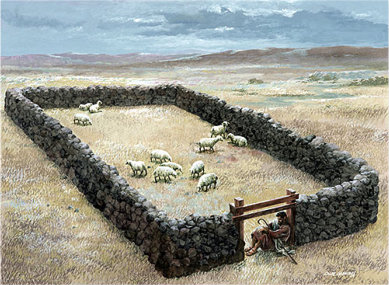by Linda McMillan
In Myaynigone, if someone is a little bit out of their mind we say that they are a broken cocoanut. That was my own first thought about Jesus’s discourse in this morning’s reading. He’s a broken cocoanut.
As a stand-alone, this reading is one of the most confounding and infuriating in all the Bible. The two choices are to embrace the inadequate and pedantic traditional interpretations, or just shake your head in disbelief. Jesus is rambling and, let’s face it, almost incoherent. Theologian and blogger Richard Swanson says this:
“I can only finish the scene by concluding that the Judeans are justified in their reaction: they conclude that Jesus is either an opponent-outsider or demon-possessed, or both.”
Fortunately, none of the passages in the lectionary are stand-alones. They are all part of a broad tapestry. If we back up a few verses we have to embrace an even bigger cast of characters, but they will help us put this difficult passage into its place in the gospel of love. That is the point of John: God loves the world.
If you’ll think back to the fourth Sunday in Lent, you’ll remember that we considered the story of the man born blind. Like all of John’s stories it has a full cast of characters, most of them have something to say, and it poses a lot of questions about light and dark, seeing and being blind to certain things, as well as a meditation on living at the margins of society, as the man born blind did.
One of the most remarkable aspects of this story is the turning of the tables on who is really blind. The man born blind, of course, couldn’t see. But, from his position at the margins, outside the community, he was able to see certain things that those insiders, the movers and shakers, did not see. You might say that he had some enlightenment, that he was not as much in the dark as people thought he was. The townspeople, though, were not able to recognize him after he gained his sight. They became blind to the most obvious thing in the world: This man whom they had seen day after day surely appeared the same, but because he was no longer in the place of blind beggar they suddenly couldn’t see him, if they ever had.
When people get out of their place they upset the order of things. Maybe someone will get uppity, or suddenly refuse to kowtow, maybe they are healed, or become ill, have a change of fortunes, go to jail, disagree – whatever the change, it is jarring. People don’t like it. They refuse to see. If you have ever been made invisible because of your status, your skin color, sexual orientation, anything at all, you know that being ignored and unseen, is one of the most hurtful means of discrimination. You are just invisible.
That is what happened to the man born blind. Even though he was no longer blind people wouldn’t let him join in the life of the community. They had placed him in certain categories: blind, beggar, poor, outsider, invisible. When he tried to move out of those categories… Well, it just wasn’t happening.
This is the situation Jesus was addressing in today’s discourse. The man born blind might even have been there listening in, maybe his parents (who claimed they didn’t know him!) were there. This is the set-up. It’s a sign. Jesus does a lot of signs in John, and then he follows them up with a little talk about it. Sometimes he includes one of his famous I AM statements. These are characteristics of this book: Signs, discourse, I am statements.
If we continue thinking about the man born blind – and I’ll get to today’s reading, I promise – But, if we keep thinking about the man born blind, now sighted, we have to wonder what he is hoping for. He can see, but what are his hopes and dreams now? Obviously, he wants in. He has been an outsider, but now he wants in: Into the community, into the flow of life, into the job market, into relationships, independence, dignity, respect. The man wants in, and what he needs is a gate. A gate is a way in.
It was just at this moment that Jesus made one of his famous I AM statements. He said, I am the gate. That’s exactly what the man born blind needed! A gate. With this I AM statement Jesus announced that he has come to let everybody in. There will not be any unseen beggars at the margins of the Kingdom of God, everybody is part of the life flow of God. Jesus can make this statement because he is the gate. “I am the gate for the sheep,” is what he says.
 There is one interesting little thing about sheep which makes them a very good bit of imagery for this discourse. You probably know that sheep have funny looking eyes. Their eyes have a wide horizontal slit. This enables them to have a very wide range of vision. In fact, sheep can see behind themselves without turning their heads. But they have trouble seeing what is right in front of them. In a way they are both sighted and unsighted. The author of John might say that they walk in both darkness and light, just like the man born blind did.
There is one interesting little thing about sheep which makes them a very good bit of imagery for this discourse. You probably know that sheep have funny looking eyes. Their eyes have a wide horizontal slit. This enables them to have a very wide range of vision. In fact, sheep can see behind themselves without turning their heads. But they have trouble seeing what is right in front of them. In a way they are both sighted and unsighted. The author of John might say that they walk in both darkness and light, just like the man born blind did.
Some people have said that they don’t like being called sheep. It is true that they are smelly, but overall I don’t object to it at all. The illustration works perfectly with this discourse, and what are the other options? Would they prefer cows, or goats? It is perfectly fine to be called a sheep.
It is human nature to read this passage and want to know who is who. If we are the sheep, and Jesus is the gate, then who is the thief? It’s Judas. Three times in this passage the writer talks about sheep thieves, in verses 1, 8, and 10. But he only talks about them one other time and that is in relation to Judas in 12:6. There are no sheep thieves trying to poach Christians out of their congregations. That’s made up. This is a little glimpse into the future, a quick look at Jesus’s pending betrayal, that’s all.
The passage is neater and tidier than it appears at first glance. We have everybody in their place now, don’t we? But, that is just the point… we don’t have anybody in any place. Jesus is the gate that lets everybody through! We are all the sheep, sure, and also the gate, and also the thief.
Maybe you’ve been stuck in some category of person that you’d like to break out of. The discourse today gives you hope for breaking out of the small sheep pen you may have become trapped in. Jesus is the gate. Look to him. Go forth little lamb, the whole pasture is for you!
Maybe you have refused to let others grow into the new creatures they are becoming. Have you been blind to the growth in others? What new life do you see in them that you can help cultivate? Who has been unseen? You are also the gate. Let people in. There are no outcasts in the Kingdom of God, no beggars on the periphery. Each one of us has a place in the beloved community. Be the inviting gate!
And let us never forget that there are thieves who come to squash out the little lives which are trying to grow in our midst… and that we are the thieves. Don’t be the thief.
Lambs, gates, and thieves… Oh, my! What a whirlwind we had this week!
Linda McMillan lives in Yangzhong, China.
Image: Sheepfold in Jesus’ time and sheep eyes
Some Notes of Possible Interest
Myaynigone is a township of Yangon, Myanmar
Richard Swanson’s blog is Provoking The Gospel. He is the author of several books including the one from which this passage is taken: Provoking the Gospel of John: a storyteller’s commentary, years A, B, & C, Richard Swanson – Pilgrim Press – 2010. His books are available on Amazon, but they aren’t cheap. They are not yet in Kindle format.
Some of the more unsatisfactory interpretations including the idea that followers of Jesus are sheep and that Jesus is our shepherd; some say that other religious traditions, or even other Christian traditions, are the thieves who will try to talk you off the one true path; some people even say that becoming a Christian is the only way to participate in the Kingdom of God and that all others will miss out on the Heavenly Banquet. It’s crazy, but that’s what people have said. The result has been anti-Judaism and exclusivism. Neither are reflective of the real message of John which is Love, Light, Logos.
Jesus did seven signs in John:
John 2:1-12… turns water to wine
John 4:43-54… heals the son of an official
John 5:1-15… heals a lame man at Bethesda
John 6:1-15, 25-69… feeds a bunch of people
John 6:16-21… walks on water.
John 9:1-41… heals the man born blind
John 11:1-44… Lazarus
Jesus made seven I AM statements in John. Some people try to match these up with other passages in the Bible. You can do that. I don’t find it particularly helpful:
John 6:35… I AM the Bread of Life”
John 8:12… “I AM the Light of the World
John 10:7… “I AM the Door
John 10:11… “I AM the Good Shepherd
John 11:25… “I AM the Resurrection and the Life”
John 14:6… I AM the Way, the Truth, and the Life” …
John 15:1… “I AM the True Vine” …
This is off-topic, but one thing that is kind of interesting is to compare these I AM statements to John The Baptist’s I AM NOT statements!
John 1:20… I am not the messiah
John 1:21… I am not (Are you Elijah?)
John 1:27… I am not worthy to untie the thong… sandal
John 3:28… I am not the messiah
There’s a lot of interesting information about sheep here.
Edmond Lee Browning was the 24th Presiding Bishop of The Episcopal Church. He is best remembered for seeking to make the church a place where there are no outcasts.

